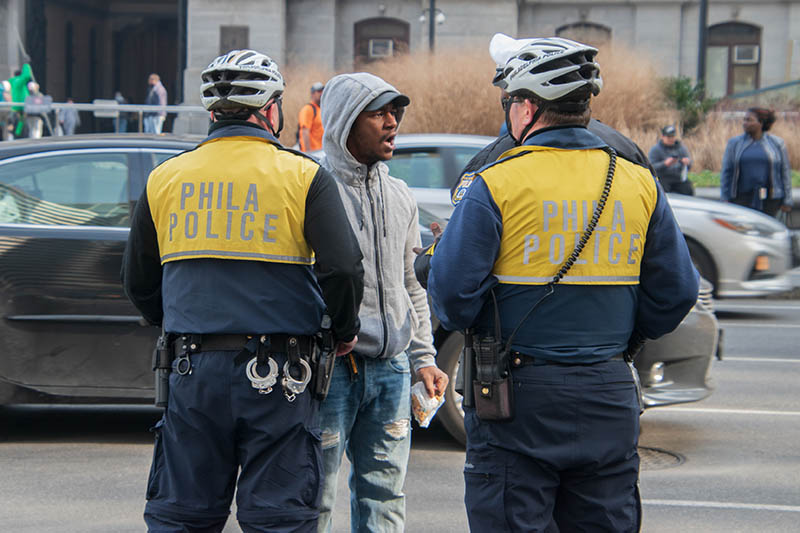As criminologists with expertise in policing and law, we previously explained that stop-and-frisk can be both constitutional and useful if carefully controlled.
Violent crime, and how to reduce it, dominated the 2023 Philadelphia mayoral campaign. As a candidate, Cherelle Parker suggested she would support using stop-and-frisk to combat gun violence. After being elected, Parker reiterated her stance, but emphasized “there is no place for unconstitutional stop-and-frisk”.
The ACLU of Philadelphia objected to the incoming mayor’s position during the campaign. The civil liberties advocacy organization pointed to the lawsuit it brought against the Philadelphia Police Department in 2010, stop data that continued to show persistent racial disparities, and the lack of empirical support for the effectiveness of the strategy.
As criminologists with expertise in policing and law, we previously explained that stop-and-frisk can be both constitutional and useful if carefully controlled. We agree with the Philadelphia Inquirer observation that this “requires a change in culture and accountability”.
Below, we explain what stop-and-frisk is and how it has been used in Philadelphia. Then we describe those critically important controls.
What is stop-and-frisk?
In the landmark 1968 ruling Terry v. Ohio, the US Supreme Court authorized law enforcement to briefly detain and question criminal suspects based on reasonable, “articulable” suspicion.
This standard of proof involves more than a hunch – but less than probable cause – that the person stopped is involved in criminal activity.
This standard of proof involves more than a hunch – but less than probable cause – that the person stopped is involved in criminal activity. If there are reasonable grounds to believe the person is armed, officers may conduct a limited pat-down to check for weapons.
Over the next few decades, police departments across the US morphed this tool into a broad, unconstitutional crime-control strategy that Howard University Law Professor Andrew E Taslitz writes often relied on “stereotypes, assumptions, [and] guilt-by-association”.
History of stop-and-frisk in Philadelphia
In Philadelphia, stop-and-frisk gained a foothold in the 1990s. By 2007, it was broadly instituted as a formal policy.
Two years later, Philadelphia police stopped more than 253,000 people. African Americans accounted for more than 70% of these stops even though they comprised 43% of the city’s population at the time. Only 8.4% of stops resulted in arrests.
These disparities led to the class-action lawsuit in 2010. Philadelphia settled the lawsuit in 2011 by entering into a consent decree, a type of legal agreement. The city promised to train its police officers on the legal parameters for valid stop-and-frisks, monitor how police conduct them, and discipline those who engaged in unconstitutional practices.
Philadelphia curtailed its use of stop-and-frisk in 2015 but never entirely abandoned the tactic. Racial disparities persist. Nearly 40% of stops conducted in 2019 lacked reasonable suspicion, thereby violating the Fourth Amendment protection against unreasonable search and seizures.
Measuring effectiveness
As the ACLU of Pennsylvania noted, at best “stop-and-frisk is a scary inconvenience.” The “average Philadelphia pedestrian stop lasts 13 minutes” – long enough to delay people for work, child care or other key responsibilities.
Worse, encounters with the police have the potential to turn violent, with police disproportionately using force against Black and Hispanic men. And as the deaths of Michael Brown, Eric Garner and Tyre Nichols illustrate, stop-and-frisks against men of color can end with police using deadly force.
Perhaps counter-intuitively, aggressive policing strategies like stop-and-frisk have the potential to increase crime. That’s because they can create more distrust of law enforcement among people of color whom police target.
Notably, Black men are 2.5 times more likely than white men to be killed by police, although police killings are the sixth-leading cause of death among men of all races aged 25 to 29. Despite these consequences, Philadelphia’s recent surge in violence prompted calls for re-implementation of a broad stop-and-frisk strategy.
Some people believe the strategy works because between 2007 and 2009, a period when Philadelphia aggressively employed stop-and-frisk, homicides decreased by roughly 22%. But crime data shows that when the city reduced its use of stop-and-frisk under the terms of the consent decree, violent crime did not significantly increase.
As Philadelphia’s public radio station WHYY explained, the “major spike in gun violence didn’t begin until 2019, and it worsened during the sustained period of socioeconomic instability following the COVID-19 pandemic”.
Indeed, firearm violence and homicides rose nationwide during the pandemic. Experts say this trend “is much more likely related to unemployment, racism, mental health, and other systemic causes than it is to policing practices”.
Perhaps counter-intuitively, aggressive policing strategies like stop-and-frisk have the potential to increase crime. That’s because they can create more distrust of law enforcement among people of color whom police target. In turn, people in communities of color may then be less likely to call police and cooperate with them.
A road map to avoid past problems
So what would we tell Mayor-elect Parker and her choice for police commissioner, Kevin Bethel, if they asked us how to make it work? We would share these evidence-based suggestions that could minimize bias if stop-and-frisk were more widely implemented in Philadelphia.
1: Enhance and sustain efforts to recruit diverse officers. Like many police departments, Philadelphia’s faces staffing shortages. The city is using its recruitment efforts as an opportunity to attract a racially diverse applicant pool, a positive step.
We’d also suggest evaluating police recruits’ racial attitudes and eliminate anyone from that pool who demonstrates racial biases.
By following these guidelines, we believe police in Philadelphia – and elsewhere – can use stop-and-frisk as a lawful mechanism to reduce crime and violence, while honoring residents’ constitutional rights.
2: Pair stop-and-frisk training with implicit bias training, which educates officers on the subtleties of how racial biases can affect their decision-making. Police departments can also provide procedural justice training, which promotes fair, respectful treatment of community members.
3: Train police on the constitutional requirements of the tactic. As the court-appointed monitor for the New York City Police Department, Peter Zimroth, observed, officers need to understand the legal framework for stop-and-frisks, and the types and levels of proof they need to satisfy before making them.
4: Implement community engagement strategies to offset some of the harms that stop-and-frisk can cause. For example, Mayor Parker’s current safety plan includes hiring 300 foot and bike patrol officers who have the potential to engage the community in ways that build support for policing operations.
That’s smart, if they adhere to constitutional mandates and the tenets of community policing and procedural justice.
5: Require officers to complete a written report for each stop-and-frisk, and have supervisors review them regularly.
6: Require officers, with their body-worn cameras turned on, to articulate why they are stopping someone. Their reasons should also be conveyed to the person who is stopped.
7: Harness body cam footage to monitor stop-and-frisk. Researchers examining the NYPD’s program concluded that body cams increased compliance with stop-and-frisk reporting requirements.
Supervisors should routinely review footage to assess the constitutionality of stops and the interactions that follow. Police departments might explore using artificial intelligence technology to examine the vast amounts of footage they capture.
By following these guidelines, we believe police in Philadelphia – and elsewhere – can use stop-and-frisk as a lawful mechanism to reduce crime and violence, while honoring residents’ constitutional rights.
Without these essential controls, however, the failed history of stop-and-frisk is doomed to be repeated.
This article first appeared on The Conversation, and is republished under a Creative Commons Licence; the original can be read here.
About the Authors
 Michael D White is a Professor in the School of Criminology and Criminal Justice at Arizona State University, and is Associate Director of ASUs Center for Violence Prevention and Community Safety. He is also director of the doctoral program in Criminology and Criminal Justice at ASU. Prof White is co-director of training and technical assistance for the US Department of Justice Body-Worn Camera Policy and Implementation Program. Prof White’s primary research interests involve the police, including use of force, technology, and misconduct; prior to entering academia, he worked as a deputy sheriff in Pennsylvania.
Michael D White is a Professor in the School of Criminology and Criminal Justice at Arizona State University, and is Associate Director of ASUs Center for Violence Prevention and Community Safety. He is also director of the doctoral program in Criminology and Criminal Justice at ASU. Prof White is co-director of training and technical assistance for the US Department of Justice Body-Worn Camera Policy and Implementation Program. Prof White’s primary research interests involve the police, including use of force, technology, and misconduct; prior to entering academia, he worked as a deputy sheriff in Pennsylvania.
 Henry F. Fradella is a Professor in the School of Criminology and Criminal Justice at Arizona State University, where he also holds an affiliate appointment in the Sandra Day O’Connor College of Law. He is the author, co-author, or editor of 13 books, and has written roughly 120 articles, book chapters, reviews, and scholarly commentaries. Much of his work deals with the intersection of crime, law, and sexuality, addressing such topics as bullying, sexting, rape law reform, intimate partner violence, marriage equality, transgender rights, and the criminalization and decriminalization of ‘consensual’ sex offenses.
Henry F. Fradella is a Professor in the School of Criminology and Criminal Justice at Arizona State University, where he also holds an affiliate appointment in the Sandra Day O’Connor College of Law. He is the author, co-author, or editor of 13 books, and has written roughly 120 articles, book chapters, reviews, and scholarly commentaries. Much of his work deals with the intersection of crime, law, and sexuality, addressing such topics as bullying, sexting, rape law reform, intimate partner violence, marriage equality, transgender rights, and the criminalization and decriminalization of ‘consensual’ sex offenses.
Picture © Alan Budman / Shutterstock


